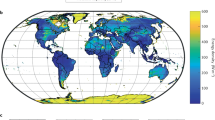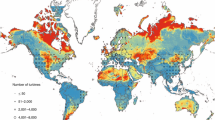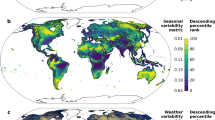Abstract
Cost-effective expansion of the wind energy industry benefits from robust estimates of wind resource and operating conditions. Extreme design loads contribute to wind turbine selection and cost, and are determined in part by the fifty year return period sustained wind speed (U50). Here we derive a global, homogenized and geospatially explicit digital atlas of U50 and associated confidence intervals based on ERA5 reanalysis output at wind turbine hub heights. U50 estimates derived using ERA5 output and four different methods are shown to lie within an average of 9–13% of those from point measurements. The reference wind speed (Uref) derived using five times the mean wind speed as specified in the wind turbine design standards is generally a conservative estimate of U50. Particularly after application of additional safety factors, this may result in over-engineering of wind turbines and excess capital expenditures.
This is a preview of subscription content, access via your institution
Access options
Access Nature and 54 other Nature Portfolio journals
Get Nature+, our best-value online-access subscription
$29.99 / 30 days
cancel any time
Subscribe to this journal
Receive 12 digital issues and online access to articles
$119.00 per year
only $9.92 per issue
Buy this article
- Purchase on Springer Link
- Instant access to full article PDF
Prices may be subject to local taxes which are calculated during checkout







Similar content being viewed by others
Data availability
ERA5 data are available from https://climate.copernicus.eu/climate-reanalysis. Netcdf files containing the digital atlas are available for download from ZENODO (https://doi.org/10.5281/zenodo.4306822). An Excel spreadsheet containing U50 estimates from in situ observations is given as Supplementary Data 1.
Code availability
Matlab code used to compute Uref and U50 estimates can be downloaded from ZENODO at https://doi.org/10.5281/zenodo.4306822.
References
Global Wind Report 2019 (Global Wind Energy Council, 2020); https://gwec.net/global-wind-report-2019/
Kusiak, A. Share data on wind energy: giving researchers access to information on turbine performance would allow wind farms to be optimized through data mining. Nature 529, 19–22 (2016).
Pryor, S. C., Shepherd, T. J. & Barthelmie, R. J. Interannual variability of wind climates and wind turbine annual energy production. Wind Energy Sci. 3, 651–665 (2018).
Veers, P. et al. Grand challenges in the science of wind energy. Science 366, eaau2027 (2019).
Dörenkämper, M. et al. The making of the New European Wind Atlas – part 2: production and evaluation. Geosci. Model Dev. 13, 5079–5102 (2020).
Hahmann, A. N. et al. The making of the New European Wind Atlas – part 1: model sensitivity. Geosci. Model Dev. 13, 5053–5078 (2020).
Hersbach, H. et al. The ERA5 global reanalysis. Q. J. R. Meteorol. Soc. 146, 1999–2049 (2020).
IEC 61400-1 Edition 4.0 2019-02 Wind Turbines - Part 1: Design Requirements (International Electrotechnical Commission, 2019).
Burton, T., Jenkins, N., Sharpe, D. & Bossanyi, E. Wind Energy Handbook 2nd edn (John Wiley & Sons, 2011).
IEC 61400-3-1:2019 Wind Energy Generation Systems - Part 3-1: Design Requirements for Fixed Offshore Wind Turbines 149 (International Electrotechnical Commission, 2019).
Hamilton, S. D., Millstein, D., Bolinger, M., Wiser, R. & Jeong, S. How does wind project performance change with age in the United States? Joule 4, 1004–1020 (2020).
Ziegler, L., Gonzalez, E., Rubert, T., Smolka, U. & Melero, J. J. Lifetime extension of onshore wind turbines: a review covering Germany, Spain, Denmark, and the UK. Renew. Sustain. Energy Rev. 82, 1261–1271 (2018).
Wiser, R. H. & Bolinger, M. Benchmarking Anticipated Wind Project Lifetimes: Results from a Survey of US Wind Industry Professionals. (Berkeley Lab, Electricity Markets and Policy Group, 2019); https://emp.lbl.gov/publications/benchmarking-anticipated-wind-project
Junginger, M., Hittinger, E., Williams, E. & Wiser, R. in Technological Learning in the Transition to a Low-Carbon Energy System (eds Junginger, M. & Louwen, A.) 87–102 (Elsevier, 2020).
Zhang, D. et al. Economic and sustainability promises of wind energy considering the impacts of climate change and vulnerabilities to extreme conditions. Electr. J. 32, 7–12 (2019).
Steffen, B. The importance of project finance for renewable energy projects. Energy Econ. 69, 280–294 (2018).
Rohrig, K. et al. Powering the 21st century by wind energy—options, facts, figures. Appl. Phys. Rev. 6, 031303 (2019).
Pryor, S. C., Conrick, R., Miller, C., Tytell, J. & Barthelmie, R. J. Intense and extreme wind speeds observed by anemometer and seismic networks: an eastern US case study. J. Appl. Meteorol. Climatol. 53, 2417–2429 (2014).
Peterka, J. A. Improved extreme wind prediction for the United States. J. Wind Eng. Ind. Aerodyn. 41, 533–541 (1992).
Vickery, P. J. et al. Ultimate wind load design gust wind speeds in the United States for use in ASCE-7. J. Struct. Eng. ASCE 136, 613–625 (2010).
Kalverla, P. C., Holtslag, A. A. M., Ronda, R. J. & Steeneveld, G. J. Quality of wind characteristics in recent wind atlases over the North Sea. Q. J. R. Meteorol. Soc. 146, 1498–1515 (2020).
Olauson, J. ERA5: the new champion of wind power modelling? Renew. Energy 126, 322–331 (2018).
Kalverla, P. C., Duncan, J. B. Jr, Steeneveld, G. J. & Holtslag, A. A. M. Low-level jets over the North Sea based on ERA5 and observations: together they do better. Wind Energy Sci. 4, 193–209 (2019).
Pryor, S. C., Shepherd, T. J., Bukovsky, M. & Barthelmie, R. J. Assessing the stability of wind resource and operating conditions. J. Phys. Conf. Ser. https://doi.org/10.1088/1742-6596/1452/1/012084 (2020).
Wind Powers America: Annual Report 2019 148 (American Wind Energy Association, 2020); www.awea.org
Hand, M. M. IEA Wind TCP Task 26‒Wind Technology, Cost, and Performance Trends in Denmark, Germany, Ireland, Norway, Sweden, the European Union, and the United States: 2008‒2016 NREL/TP-6A20-71844, 104 (National Renewable Energy Laboratory, 2018); https://www.nrel.gov/docs/fy19osti/71844.pdf
Pryor, S. C. et al. Analyses of possible changes in intense and extreme wind speeds over northern Europe under climate change scenarios. Clim. Dyn. 38, 189–208 (2012).
Vose, R. S. et al. Monitoring and understanding changes in extremes: extratropical storms, winds, and waves. Bull. Am. Meteorol. Soc. 95, 377–386 (2014).
Hodges, K. I., Lee, R. W. & Bengtsson, L. A comparison of extratropical cyclones in recent reanalyses ERA-Interim, NASA MERRA, NCEP CFSR, and JRA-25. J. Clim. 24, 4888–4906 (2011).
Manganello, J. V. et al. Tropical cyclone climatology in a 10-km global atmospheric GCM: toward weather-resolving climate modeling. J. Clim. 25, 3867–3893 (2012).
Pryor, S. C. et al. Wind speed trends over the contiguous United States. J. Geophys. Res. Atmos. 114, D14105 (2009).
Cook, N. J., Harris, R. I. & Whiting, R. Extreme wind speeds in mixed climates revisited. J. Wind Eng. Ind. Aerodyn. 91, 403–422 (2003).
Camargo, S. J. & Wing, A. A. Tropical cyclones in climate models. Wiley Interdiscip. Rev. Clim. Change 7, 211–237 (2016).
Kumar, D., Mishra, V. & Ganguly, A. R. Evaluating wind extremes in CMIP5 climate models. Clim. Dyn. 45, 441–453 (2015).
Bastine, D., Larsen, X., Witha, B., Dorenkamper, M. & Gottschall, J. Extreme winds in the New European Wind Atlas. J. Phys. Conf. Ser. 1102, 012006 (2018).
Larsén, X. G. & Kruger, A. Application of the spectral correction method to reanalysis data in South Africa. J. Wind Eng. Ind. Aerodyn. 133, 110–122 (2014).
Larsen, X. G. & Mann, J. The effects of disjunct sampling and averaging time on maximum mean wind speeds. J. Wind Eng. Ind. Aerodyn. 94, 581–602 (2006).
Pryor, S. C., Letson, F. W. & Barthelmie, R. J. Variability in wind energy generation across the contiguous USA. J. Appl. Meteorol. Climatol. 59, 2021–2039 (2020).
Malakar, P., Kesarkar, A., Bhate, J., Singh, V. & Deshamukhya, A. Comparison of reanalysis data sets to comprehend the evolution of tropical cyclones over North Indian Ocean. Earth Space Sci. 7, e2019EA000978 (2020).
Tarp-Johansen, N. J. & Clausen, N.-E. Design of Wind Turbines in Typhoon Area: a First Study of Structural Safety of Wind Turbines in Typhoon rone Areas 22 (EC-ASEAN Energy Facility, Risoe National Laboratory, 2006); https://orbit.dtu.dk/
Schreck, S., Lundquist, J. & Shaw, W. J. US Department of Energy Workshop Report: Research Needs for Wind Resource Characterization Report no. NREL/TP-500-43521 (National Renewable Energy Lab, 2008); https://www.osti.gov/servlets/purl/935107
Simiu, E. & Yeo, D. Wind Effects on Structures: Modern Structural Design for Wind (John Wiley & Sons, 2019).
Letson, F., Pryor, S. C., Barthelmie, R. J. & Hu, W. Observed gust wind speeds in the coterminous United States, and their relationship to local and regional drivers. J. Wind Eng. Ind. Aerodyn. 173, 199–209 (2018).
Pintar, A. L., Simiu, E., Lombardo, F. T. & Levitan, M. L. Maps of Non-hurricane Non-tornadic Wind Speeds With Specified Mean Recurrence Intervals for the Contiguous United States Using a Two-Dimensional Poisson Process Extreme Value Model and Local Regression Special Publication 500-301 (National Institute of Standards and Technology, 2015); https://doi.org/10.6028/NIST.SP.500-301
Skamarock, W. C. Evaluating mesoscale NWP models using kinetic energy spectra. Mon. Weather Rev. 132, 3019–3032 (2004).
Larsén, X. G., Larsen, S. E. & Petersen, E. L. Full-scale spectrum of boundary-layer winds. Bound. Layer Meteorol. 159, 349–371 (2016).
Offshore Wind in Europe: Key Trends and Statistics 2018 40 (Wind Europe, 2019); https://windeurope.org/wp-content/uploads/files/about-wind/statistics/WindEurope-Annual-Offshore-Statistics-2018.pdf
Justus, C. G., Hargraves, W. R. & Yalcin, A. Nationwide assessment of potential power output from wind-powered generators. J. Appl. Meteorol. 15, 673–678 (1976).
Pryor, S. C., Nielsen, M., Barthelmie, R. J. & Mann, J. Can satellite sampling of offshore wind speeds realistically represent wind speed distributions? Part II: quantifying uncertainties associated with sampling strategy and distribution fitting methods. J. Appl. Meteorol. 43, 739–750 (2004).
Mann, J., Kristensen, L. & Jensen, N. O. in Bridge Aerodynamics (eds Larsen, A. & Esdahl, S.) 49–56 (Balkema, 1998).
Wilks, D. S. Statistical Methods in the Atmospheric Sciences Vol. 100 (Academic Press, 2011).
Abild, J., Mortensen, N. G. & Landberg, L. Application of the Wind Atlas method to extreme wind speed data. J. Wind Eng. Ind. Aerodyn. 421, 473–484 (1992).
Gringorten, I. I. A plotting rule for extreme probability paper. J. Geophys. Res. 68, 813–814 (1963).
Bonamente, M. Statistics and Analysis of Scientific Data 2nd edn (Springer, 2017).
Lawrence, A. Probability in Physics: an Introductory Guide (Springer, 2019).
Hazelton, M. L. in International Encyclopedia of Statistical Science (ed. Lovric, M.) 816–817 (Springer, 2011).
Young, I., Vinoth, J., Zieger, S. & Babanin, A. V. Investigation of trends in extreme value wave height and wind speed. J. Geophys. Res. Oceans 117, C00J06 (2012).
Vinoth, J. & Young, I. Global estimates of extreme wind speed and wave height. J. Clim. 24, 1647–1665 (2011).
Lombardo, F. T. Improved extreme wind speed estimation for wind engineering applications. J. Wind Eng. Ind. Aerodyn. 104–106, 278–284 (2012).
Simiu, E., Wilcox, R., Sadek, F. & Filliben, J. J. Wind speeds in ASCE 7 standard peak-gust map: assessment. J. Struct. Eng. ASCE 129, 427–439 (2003).
Harper, B. A., Kepert, J. D. & Ginger, J. D. Guidelines for Converting between Various Wind Averaging Periods in Tropical Cyclone Conditions Report no. WMO-TD-1555 (World Meteorological Organization, 2010); https://library.wmo.int/index.php?lvl=notice_display&id=135#.X_ePSuk3kp4
Cook, N. J. Towards better estimation of extreme winds. J. Wind Eng. Ind. Aerodyn. 9, 295–323 (1982).
Dukes, M. D. G. & Palutikof, J. P. Estimation of extreme wind speeds with very long return periods. J. Appl. Meteorol. 34, 1950–1961 (1995).
Gatey, D. A. & Miller, C. A. An investigation into 50-year return period wind speed differences for Europe. J. Wind Eng. Ind. Aerodyn. 95, 1040–1052 (2007).
Wind Energy in Europe in 2019: Trends and Statistics 25 (Wind Europe, 2020); https://windeurope.org/wp-content/uploads/files/about-wind/statistics/WindEurope-Annual-Statistics-2019.pdf
Acknowledgements
This work is supported by the US Department of Energy (DE-SC0016438 and DE-SC0016605). The research used computing resources from the National Science Foundation: Extreme Science and Engineering Discovery Environment (allocation award to S.C.P. is TG-ATM170024). We gratefully acknowledge the European Center for Medium Range Weather Forecasts staff who generated and support dissemination of the ERA5 data set, and the comments from four external reviewers.
Author information
Authors and Affiliations
Contributions
S.C.P. and R.J.B. jointly derived the concept for the research and obtained funding for the research. S.C.P. acquired the computational resources and developed and applied the research methodology and generated all figures. The authors jointly wrote the manuscript.
Corresponding author
Ethics declarations
Competing interests
The authors declare no competing interests.
Additional information
Peer review information Nature Energy thanks Andrew Clifton, Julia Gottschall, Xiaoli Guo Larsén and the other, anonymous, reviewer(s) for their contribution to the peer review of this work.
Publisher’s note Springer Nature remains neutral with regard to jurisdictional claims in published maps and institutional affiliations.
Supplementary information
Supplementary Data 1
Seventy-three observationally derived estimates of extreme wind speeds.
Rights and permissions
About this article
Cite this article
Pryor, S.C., Barthelmie, R.J. A global assessment of extreme wind speeds for wind energy applications. Nat Energy 6, 268–276 (2021). https://doi.org/10.1038/s41560-020-00773-7
Received:
Accepted:
Published:
Issue Date:
DOI: https://doi.org/10.1038/s41560-020-00773-7
This article is cited by
-
Aerosol forcing regulating recent decadal change of summer water vapor budget over the Tibetan Plateau
Nature Communications (2024)
-
Wind farm site selection using GIS-based multicriteria analysis with Life cycle assessment integration
Earth Science Informatics (2024)
-
Assessment of the wind power density over South America simulated by CMIP6 models in the present and future climate
Climate Dynamics (2024)
-
Climate change impacts on planned supply–demand match in global wind and solar energy systems
Nature Energy (2023)
-
Poleward intensification of midlatitude extreme winds under warmer climate
npj Climate and Atmospheric Science (2023)



